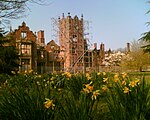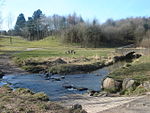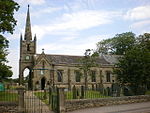River Yarrow (Lancashire)

The River Yarrow is in Lancashire, with its source at an area called Will Narr at Hordern Stoops, along Spitlers Edge - the Chorley/Blackburn boundary - on the West Pennine Moors. The river feeds the Yarrow Reservoir, which in turn feeds the Anglezarke and Upper and Lower Rivington Reservoirs. Upon leaving the reservoirs via a pumping station, the river passes through an area that was formerly known as Abyssinia. Currently, this area is within the boundaries of Heath Charnock and Limbrick, but the original name was given because it was a route frequented by coal miners, and the workers were said to look like natives of Abyssinia (modern day Ethiopia): until the mid 20th century it was usual for miners to return from work covered in coal dust.From here, the river flows underneath the Leeds and Liverpool Canal, joining Black Brook at Yarrow Bridge, then continuing through the ancient woodland of Duxbury into Yarrow Valley Park forming a boundary of Euxton and on through Eccleston and Croston, where it feeds the River Douglas at Sollom just before its inlet into the River Ribble's brackish final stretch. The entire course of the River Yarrow falls within Chorley and its villages. Parts of the river are a County Biological Heritage Site.
Excerpt from the Wikipedia article River Yarrow (Lancashire) (License: CC BY-SA 3.0, Authors, Images).River Yarrow (Lancashire)
Eyes Lane,
Geographical coordinates (GPS) Address Nearby Places Show on map
Geographical coordinates (GPS)
| Latitude | Longitude |
|---|---|
| N 53.661516666667 ° | E -2.8090833333333 ° |
Address
Eyes Lane
Eyes Lane
PR26 9AS , Bretherton
England, United Kingdom
Open on Google Maps









